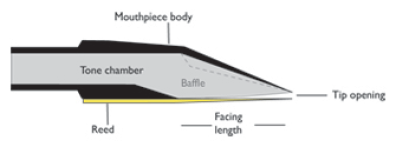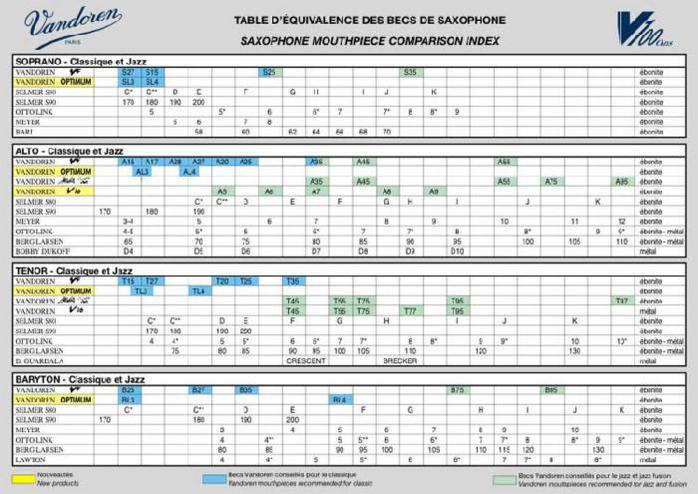
As mentioned, a very wide subject, covered briefly under sax terms.
There are innumerable mouthpiece manufacturers, each of them with a variety of styles and designs intended to produce different sounds although not all the distinctions between mouthpieces are audible. A saxophone will invariably come with an inexpensive mouthpiece, as indeed do most serious horns, probably under the assumption that a professional horn player will have a favorite mouthpiece, and will be unlikely to use the one that came with his or her new horn. Plastic mouthpieces typically won't bring out the best in any horn.
A sax mouthpiece has several important functions. It holds the reed, and keeps it from flapping about too much. It also provides a chamber which modifies the sound of a vibrating reed. Finally, it provides a precise gap between the flat surface of the reed and the material it's resting against, across which the reed can vibrate. The size and shape of a sax mouthpiece will have a pronounced effect on the sound your horn produces, as will the material your mouthpiece is made of. I personally believe that a mouthpiece accounts for around 60% of the sound quality and tone that a saxophone produces. Therefore, if budget is limited, always change your mouthpiece for anything up to £2-300 rather than spending £000s on a new saxophone.
The chamber behind the reed in a mouthpiece is the most determining aspect of its design. A large chamber will tend to emphasize the lower tones generated by the reed (the lower "harmonics"). A smaller chamber will emphasize the higher tones. As such, large chamber mouthpieces are more suitable for classical music, and small chamber mouthpieces will enhance the brighter aspects of a horn for jazz. The face of the open portion of the chamber of a mouthpiece which is covered by a reed isn't perfectly flat. It curves away from the reed, to allow the reed room to vibrate. This "tip opening" size also has an effect on the tone produced by a mouthpiece. A large tip opening allows for softer reeds, which in turn produce darker tones. A small tip opening suits harder reeds, and brighter, jazzier tones. Most professional saxophone mouthpieces are made of hard rubber or metal. Hard rubber mouthpieces are very dense, and they tend to dampen higher-pitched sounds. They favor a darker, warmer sound, and suit classical performance. Metal mouthpieces are less dense, and enhance higher tones. They favour jazz more.
There are two main types of mouthpiece - plastic (ebonite) and metal. As a general rule plastic mouthpieces give a darker, richer, smoother sound while metal mouthpieces are brighter, louder and slightly more edgy. There are exceptions to the above of course and this will be due to the shape of the chamber, the shape/type of baffle (if any) and the facing/tip opening.
Most starter saxes come with a 'student' mouthpiece. These are plastic, have a small tip opening and no baffles. They are very easy to blow, especially when used with reeds of strength 1½ or 2 and therefore great for starting off, but tend to produce a thinner sound. As a player's embouchure and muscles develop, the progression is towards a mouthpiece with a larger tip opening along with slightly harder strength reeds, and so a warmer, richer sound. Each player is different, but I would suggest a player moves on from a student mouthpiece after about a year or so.
The only way to work out what's best for you is to try some out. Most good woodwind shops offer a facility where you are able to try a selection of mouthpieces in a 'practice room'. Give them a budget, tell them the kind of sound you're looking for, take along a reed you're happy with and spend a few minutes playing each one. I say mention a budget because ebonite mouthpieces range from £100 to £250 while metals range from £150 to £500!
Below is a mouthpiece comparison chart produced by Vandoren. As you can see, each manufacturer has a different system of denoting the shape/tip opening. The larger the number the wider the tip opening.

To summarise then: classical and baroque music is usually played with soft reeds, which require a larger tip opening. Soft reeds and large tip openings favour lower tones, and will produce a darker, richer sound.
Jazz is usually played with harder reeds, which can accommodate smaller tip openings. Hard reeds and small tip openings favour higher tones, and will produce a brighter, more forward and dynamic sound.